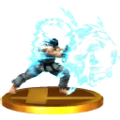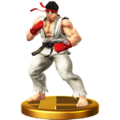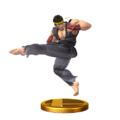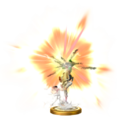Ryu (SSB4)
| Ryu in Super Smash Bros. 4 | |
|---|---|
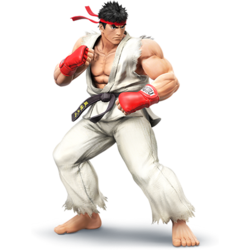 
| |
| Universe | Street Fighter |
| Availability | Downloadable |
| Final Smash | Shin Shoryuken / Shinku Hadoken |
| “ | Here Comes A New Challenger! Ryu | ” |
| —Introduction tagline | ||
Ryu (リュウ, Ryū) is a playable character and newcomer in Super Smash Bros. 4 as the fourth downloadable character. Ryu was revealed and released alongside Lucas and Roy on June 14th, 2015. Ryu was the fourth third-party character to be revealed in the game, the others being Sega's Sonic, Bandai Namco's Pac-Man, and Capcom's Mega Man.
Like in Street Fighter IV and its update versions, Ryu is voiced by Hiroki Takahashi in Japanese and Kyle Hebert in English.
Attributes
Ryu is an average-sized heavyweight fighter with decent mobility and recovery, who possesses a mix of combo-based moves and finishing moves with very high knockback. Apart from these, some of his traits are similar to Mario's, such as his dashing speed and the individual damage output of his attacks. This owes to the fact that Ryu, like Mario, is an "all-rounder" fighter in his home series. Ryu's controls are unique in the Super Smash Bros. series and attempt to emulate the control scheme of his home series: the strength of his attacks depend on how long the attack button is pressed (tap for a weak attack, and hold for a strong attack), and his neutral, side and up special moves can be inputted using half-circle and quarter-circle motions plus either attack button for stronger variations. Generally, his tapped tilts are good at chaining with one another due to their low knockback and speed, which gives him a unique combo-based damage racking playstyle. This works by keeping opponents in hitstun before knocking opponents away by ending any combo chain with a finisher (typically a held tilt attack or inputted special move), similar to the combos in his home series. Additionally, all of Ryu's special attacks (sans Focus Attack) gain benefit from using his unique button inputs, as they do more damage and knockback or have additional effects when done with inputs compared to just with the special button, making mastery of his button inputs imperative if the player wishes to deal higher damage and knockback at all times, especially since they can also be used as a reliable finisher for his tilt combo chains. Effectively, this means Ryu is the only character to have true combos from almost any tilt, allowing him to immediately switch from damage racking to a finisher instantaneously.
Ryu's moveset hence rewards players who know how to reliably use his special inputs and chain them together, and he excels at grounded combos that overwhelm opponents with quick, low knockback attacks that can be mixed up with his multiple special moves. Because Ryu's unique mechanics deliberately give him the true combos necessary for many characters' competitive success, he is considered a high-tier character overall, and has the best tournament representation out of the four DLC characters. Despite this, Ryu's learning curve is very high; much practice is generally required for his command specials in order to use them reliably and consistently rather than accidentally using the wrong move, such as self-destructing with Tatsumaki Senpukyaku when a Hadoken variant was intended.
Update history
Ryu has hardly changed since his debut in update 1.0.8. Update 1.1.0 only increased the length of his turn around animation, allowing the player to more easily use his command inputs without accidentally turning him around. However, the same update's changes to shield mechanics, most notably the universal increase in shieldstun, greatly helped Ryu by enhancing his combo game as well as Collarbone Breaker and Focus Attack's shield breaking capabilities.
 Ryu's turn around animation length increased: 2 frames → 5.
Ryu's turn around animation length increased: 2 frames → 5.
Moveset
| Name | Damage | Description | ||
|---|---|---|---|---|
| Neutral attack | 2%, 3%, 5% (tapped); 10% (held) | Tapped: Ryu performs a jab, a cross and then a hook. Tapping the button without Ryu hitting anything makes him repeat the first hit as fast as the player can tap. His weak attack combo is based off his standing light attack, close medium punch from Street Fighter II and standing hard punch in that order from Street Fighter III. Held: Ryu performs a reverse roundhouse kick. Despite being categorized as a jab, it has surprisingly high knockback and can KO beginning at 125%. The held attack is based off of his standing heavy kick in Street Fighter II. | ||
| Forward tilt | Collarbone Breaker (held) | 6.8% (tapped); 3%, 6% (held) | Tapped: A front kick, which sends the opponent up diagonally. Good for following with a dash attack at low percents. Based off Ryu's standing medium kick in Street Fighter III. Held: Collarbone Breaker: Ryu winds up his right fist before punching downwards, hitting twice quickly. Deals high damage to shields and is designed to break them, but the attack's start-up makes it difficult to use on quick fighters. A tapped up tilt can lead into this move. | |
| Up tilt | 2% (tapped); 8% (sourspot), 12% (sweetspot) (held) | Tapped: The sok ngat, an uppercut-styled elbow strike used in Muay Thai. It can be used repeatedly as fast as the player can press and as a result of its speed, it can also chain into itself and lead into many of Ryu's moves for a quick finisher. However, it has a small hitbox and short range. Based off of Ryu's close standing light punch in Street Fighter II. Held: Ryu does an uppercut. Can be a finisher for his tapped up tilt. KOs at 152%. Based off of Ryu's close standing heavy punch in Street Fighter III. | ||
| Down tilt | 1.6% (tapped); 7% (leg), 5.5% (foot) (held) | Tapped: Ryu quickly performs a crouching, Hapkido-styled shin kick. It can be repeated as fast as the player can press, similar to his other tapped tilts. If used on a prone fighter, they will be popped back onto their feet, allowing Ryu to continue combos on them for extended periods of time. Based off Ryu's crouching light kick in Street Fighter II. Held: Ryu peforms a crouching, Hapkido-styled shin kick, similar to his crouching medium attack in the original Street Fighter II. Despite having low power, it can be immediately cancelled into a special move only if Ryu hits the opponent or their shield, allowing Ryu to pressure his opponent. Shoryuken combos well with this tilt. | ||
| Dash attack | 12% (clean), 8% (late) | A flying kick. Based off of his original jumping medium and heavy kicks in the Street Fighter Alpha/Zero games. For a dash attack, it has high base knockback, and it can reliably combo into many of his tap attacks as a finisher. KOs at 140%. | ||
| Forward smash | Joudan Sokutogeri (上段足刀蹴り, "High-Level Leg Blade Kick") | 16% (leg), 17.5% (foot) | Ryu performs the Joudan Sokutogeri from Street Fighter III, a powerful side kick that moves him a step forward. It has the highest range of all his standard attacks, as it is able to hit opponents two character lengths away from him, but has noticeable endlag. Deals slightly more damage and knockback when hit with Ryu's heel; it is Ryu's strongest standard attack if the heel connects. KOs at 110% with the heel and 120% anywhere else. | |
| Up smash | 17% (clean), 13.5% (late) | A crouching uppercut, based off his crouching heavy punch in Street Fighter. Makes his profile smaller while attacking, making this a good anti-air attack. Slight endlag and does not have much horizontal reach. A good finisher for his tap combos. KOs at 130%. | ||
| Down smash | 16% (leg), 15% (foot) | A legsweep, which sends opponents at a diagonal angle. Unlike most down smashes, this only hits in front of Ryu. Quicker than his other smash attacks, with more range than his up smash but less than his forward smash, making it his safest smash attack at a distance. However, it deals extremely low knockback for a smash attack, which makes it unreliable as a KOing option, instead making it useful as a spacing option and as a way to force opponents off. A good finisher for his tap combos, like his other smashes. Based off of Ryu's crouching heavy kick in Street Fighter II. | ||
| Neutral aerial | 8% (clean), 4.5% (late) | A short-ranged punch while in a crouching position. Its limited range is benefited by the move's function as a sex kick and, when used after a short hop, it can be a useful way to lead into his up tilt or down tilt-initiated combos until the mid-50% range. Based off of Ryu's jumping light punch in Street Fighter IV. | ||
| Forward aerial | 15% (clean sweetspot), 13% (late sweetspot), 9% (clean sourspot), 8% (late sourspot) | A flying kick. Ryu's foot has high launching power, while his upper leg is the sourspot and deals less damage. Despite this, the sourspot deals high shield damage. A good combo move, and a powerful off-stage KOing option. Based off of Ryu's jumping heavy kick in Street Fighter. | ||
| Back aerial | 16% (leg), 13% (foot) | An outside crescent kick. Though it has a small hitbox, its strength and low start-up make it Ryu's most powerful aerial and a viable KOing option. KOs at 115%. Based off of Ryu's neutral jumping heavy kick from Street Fighter IV. | ||
| Up aerial | 5%, 6% | An uppercut that hits twice. Despite its appearance, it has good vertical range and is reliable at catching opponents above Ryu. KOs at 155%. Based off of Ryu's jumping medium punch in Super Street Fighter II Turbo. | ||
| Down aerial | 12% (grounded opponents), 15% (aerial opponent sweetspot), 11% (aerial opponent sourspot) | Ryu quickly punches downwards similarly to his neutral aerial, except he uses his left fist and it has more range. Hitting with the attack's sweetspot (his fist when it comes down) makes the move one of the few meteor smashes that powerfully sends opponents diagonally downwards; the sourspot sends the opponent diagonally upwards. The fastest meteor smash in the game, its angle of knockback can send opponents flying downwards off the stage if they are standing near the edge. However, it is hampered by its short range and sweetspot, which requires opponents to be right near Ryu's fist when it comes down. Hitting opponents with the sourspot can also give them an easier time recovering, as it sends them upwards. Based off of Ryu's jumping heavy punch from Street Fighter II. | ||
| Grab | — | Ryu holds his stance and reaches out with his right hand. | ||
| Pummel | 2% | Ryu knee strikes the grabbed opponent. | ||
| Forward throw | 9% | The seoi nage, a Judo throw. If the opponent does not react, this throw can lead into a down aerial meteor smash at medium percentages. Based on his punch throw from Street Fighter II. | ||
| Back throw | 12% | The tomoe nage, a Judo throw. Heavy opponents can be knocked back onto their feet with a tapped down tilt, then thrown again. Based on his kick throw from Street Fighter II. | ||
| Up throw | 8% (throw), 15% (kick) | Ryu launches the opponent directly upward with a stretch kick. It can combo into an aerial attack at low percents. It can also act as an axe kick against another opponent that comes too close to Ryu after the stretch kick. Unlike the stretch kick, the axe kick deals much more knockback and can KO at 115% at the middle of the stage. Based off of Ryu's close heavy kick from Street Fighter II. | ||
| Down throw | 5% (hit 1), 4% (throw) | Ryu throws the opponent on the ground and karate chops them, sending them in front of him at low percentages. Combos well into aerial attacks and a Shoryuken until medium percents, where thrown opponents fly too high to get hit. Based on Akuma's back throw from Street Fighter IV. | ||
| Forward roll Back roll Spot dodge Air dodge |
— | — | ||
| Techs | — | — | ||
| Floor attack (front) Floor getups (front) |
7% | Ryu kicks behind himself and then in front of himself. Based off of Ryu's crouching heavy kick from Street Fighter III. | ||
| Floor attack (back) Floor getups (back) |
7% | Ryu kicks around himself. | ||
| Floor attack (trip) Floor getups (trip) |
5% | |||
| Edge attack Edge getups |
7% | Ryu crawls up onto the stage, then kicks forward, similarly to the attack he uses when he gets up. | ||
| Neutral special | Default | Hadoken | 5, 5.5%, or 6% (standard), 1.25x damage with directional input; 1% (rapid hits 1-4), 4% (last hit) (Shakunetsu) | Ryu quickly charges and releases a blue energy-based projectile which deals low damage and knockback. Only one Hadoken can be in play: attempting to shoot another results in a puff of smoke. Holding down the special button increases projectile speed and damage slightly. Three versions of the move can be released, two with directional inputs: a small blue Hadoken (only special button), a minutely stronger and larger inputted Hadoken (↓ ↘ → and attack/special), and the red flaming Shakunetsu Hadoken that hits multiple times (← ↙ ↓ ↘ → and attack/special). Combos well into his tapped tilt attacks, and is mainly used to rack up damage due to its low damage and knockback along with its slow speed. Shakunetsu Hadoken deals some shield damage, though not to the extent of his Collarbone Breaker. However, the Shakunetsu Hadoken should be used wisely due to its abysmal priority. |
| Custom 1 | N/A | |||
| Custom 2 | N/A | |||
| Side special | Default | Tatsumaki Senpukyaku | 8% (close); 9%, 10%, or 12% (grounded); 8%, 9%, or 11% (aerial); 1.16x damage with directional input | Ryu's signature spinning outside crescent kick. It sends him forward like a top towards one direction and acts like a moving sex kick. The attack deals more damage and knockback after the first few frames. Holding down the special button increases damage and distance, and gives the attack more knockback. Using an inputted Tatsumaki Senpukyaku (↓ ↙ ← and attack/special) sees Ryu announce the move by name and results in it dealing more damage, covering more distance and even making it a viable KOing option. The move can be used as a good horizontal recovery and does not cause helplessness, but it can only be used once in the air without touching the ground. Can be a high-risk, high-reward approach option. |
| Custom 1 | N/A | |||
| Custom 2 | N/A | |||
| Up special | Default | Shoryuken | 13%, 14%, or 15% (grounded); 12%, 13%, or 14% (aerial); 12% (grounded slightly late); 10% (aerial slightly late); 7% (latest hitbox); 1.2x damage with directional input | Ryu jumps and performs his powerful signature uppercut while announcing the move's name. Holding the special button increases damage and distance. An inputted Shoryuken (→ ↓ ↘ and attack/special) deals even more knockback and damage as well as granting Ryu invincibility and no landing lag penalty. A held inputted Shoryuken is Ryu's most powerful vertical KOing option and the move with the highest knockback in his arsenal, and is also his main vertical recovery move. Ryu becomes helpless once he performs the move. |
| Custom 1 | N/A | |||
| Custom 2 | N/A | |||
| Down special | Default | Focus Attack | 12%-17% (fully charged) | Ryu holds a stance while emitting a black ink-like aura, before unleashing a concentrated punch that crumples opponents where they stand with a lengthy stun animation if charged for more than half a second. Ryu can follow up with any attack while the opponent is stuck in the animation. Ryu gains super armor that can withstand a single hit while charging; a second hit will interrupt the move. He can also cancel the move by tapping left or right twice to dash a set distance either forward or backward while charging to shrug off strong attacks before retaliating, or if the attack connects, which is called a Focus Attack Dash Cancel; if the punch misses, Ryu will be unable to cancel the move. If the move connects on an airborne opponent they will instead by knocked away with some heavy hitlag. The move's charge is indicated by Ryu flashing during the startup. With no charge, the attack will knock away opponents. At half a second, the attack will crumple an opponent, while a fully charged Focus Attack will deal more damage and crumple the opponent for longer. While the Focus Attack cannot block grabs and is countered by multi-hit attacks, it is a useful tool for baiting opponents and punishing, while the cancelled version can be beneficial to Ryu's recovery while off-stage. |
| Custom 1 | N/A | |||
| Custom 2 | N/A | |||
| Final Smash | Shin Shoryuken / Shinku Hadoken | 1% (electricity), 10% (hits 1-2), 20% (last hit) (Shin Shoryuken) / 29-30% (Shinku Hadoken) | A Final Smash that varies depending on range. At point blank range, Ryu traps the opponent in a Shin Shoryuken, a three-hit combo that sends the victim flying with an extra-powerful Shoryuken. At any other range, Ryu unleashes the Shinku Hadoken, a large Hadoken that sucks nearby opponents into it before dragging them a distance and exploding. The Shinku Hadoken is also capable of bypassing walls. Shin Shoryuken has much higher KO potential against a single target, while Shinku Hadoken has more range and reliably affects more targets. | |
Taunts
- RyuUpTauntSSB4.jpg
- RyuSideTauntSSB4.jpg
- RyuDownTauntSSB4.jpg
- Up Taunt: Turns away from the camera and tightens his headband, while stating "Come on!" (かかってこい!, Come at me!) This is one of his taunts from Street Fighter IV.
- Side Taunt: Ryu holds his fist forwards, and declares "Talk is cheap!" (拳で語り合おう!, Let your fists talk!) This is also one of his taunts from Street Fighter IV.
- Down Taunt: Stomps on the ground and grunts while in the Ansatsuken pose. This is his taunt from Street Fighter III.
Oddly, Ryu's up and side taunts have their quotes swapped from Street Fighter IV. In said game, Ryu also does not turn around while adjusting his headband.
On-Screen Appearance
Walks onto the stage from some mist in the background.
Idle Poses
- Adjusts his gloves.
- Wriggles the fingers on both hands, then crosses his arms and pumps them.
Victory Fanfare
A techno remix of the Street Fighter II Victory Theme.
Victory Poses
- RyuPose1WiiU.png
- RyuPose2WiiU.png
- RyuPose3WiiU.png
- Winds back and does a pose with his right fist facing the camera, saying "Give it your all!" (必殺のタイミングを計れ!, Gauge the timing of your special moves!). The pose is identical to his Street Fighter IV win animation.
- Slings his bag over his shoulder while saying "The journey has just begun." (旅はまだ…始まったばかりだ, Yet the journey... has just begun.).
- Punches two times before doing a victorious uppercut, while saying "Your range is one fist short." (その間合いじゃ、拳半分届かない!, That range doesn't reach half a fist!). The uppercut is a reference to one of his more recurring win poses, where he lifts a fist in the air triumphantly.
In Competitive Play
Notable players
Alternate costumes

| |||||||

|

|

|

|

|

|

|

|
Reveal Trailer
<youtube>1kalsCPXfaQ</youtube>
Ryu's reveal trailer contains many references of Street Fighter II:
- The beginning of Ryu's reveal trailer is a remake of the intro to Super Street Fighter II.
- Part of his trailer shows him using the Tatsumaki Senpukyaku and Shoryuken while being pushed by Mario's F.L.U.D.D. This references Ryu's ending in Street Fighter II where he trains by continually performing Shoryukens under a waterfall.
- The final words Ryu uses in the video, "You must defeat my Shoryuken to stand a chance", is a correct translation (which is also used in Street Fighter IV) of his win quote in Street Fighter II, and a phrase which was famously mistranslated as "You must defeat Sheng Long to stand a chance": Sheng Long was a mistranslation of Shoryuken, and the name was famously suggested by Electronic Gaming Monthly (who a decade later would create the equally notorious Melee Sonic and Tails rumor) to be a secret character in-game, which it was not.
- Ryu's poster artwork is illustrated by AKIMAN, the character designer for Street Fighter II. It is a direct imitation of a piece of promotional art for that game, with Super Smash Bros. characters substituted for the Street Fighter II cast. Donkey Kong replaces E. Honda, Wii Fit Trainer replaces Zangief, Zero Suit Samus replaces Ken, Link replaces Guile, Peach replaces Chun-Li, Pac-Man replaces Blanka, and Captain Falcon replaces Dhalsim. The Super Smash Bros. poster also adds more characters around the edges of the art.
Trophies
- Ryu
Ryu visits from the Street Fighter series! Ryu’s fighting style is based on karate, but he’s mixed in some other martial arts to make his own unique style. In Smash, he will perform either weak or strong attacks depending on if you press or hold down the buttons. His special attacks also have three power levels!
Ryu makes his Super Smash Bros. debut! His fighting style is based on a form of karate, but he's mixed in some other martial arts to make his own unique style. Here his attacks can be weak or strong depending on whether you press or hold the buttons. Each of his specials have 3 levels of power using the same method.
- Ryu (Alt.)
Ryu's down special, Focus Attack, allows him to withstand a single attack and then unleash a counter. The longer you hold the button, the longer a standing enemy will be stunned if you hit them. An enemy in the air will fall slowly, defenceless. When that happens, cancel the Focus Attack and go for the knock-out!
- Shin Shoryuken / Shinku Hadoken
Use this attack when Ryu is far away from an enemy to unleash a Shinku Hadoken that penetrates through the stage. But if you use it when Ryu is close to an enemy, he’ll unleash a Shin Shoryuken uppercut attack. When it hits, Ryu will follow up with his other fist and launch the opponent up, up, and away!
Ryu's Final Smash takes on two different forms depending on how close Ryu is to the enemy. If he's farther away, he'll use Shinku Hadoken, a move that pulls in any enemies nearby. If closer, he'll instead use Shin Shoryuken. He'll hit the enemy once with a powerful uppercut, then follow it up with the other fist to finish the job!
Gallery
Shin Shoryuken used on Captain Falcon on Suzaku Castle.
Attacking Samus.
Shakunetsu Hadoken.
Trivia
- Ryu's "Challenger Approaching" image on the official website says "Here comes a new challenger!" instead of the usual "Warning! Challenger approaching!", a reference to the fact that when a player is in single-player mode in Street Fighter games, another player can join any time, which the game will interrupt with the aforementioned tagline. Interestingly, this is done in English even on the Japanese site, where "参戦!!" is normally used.
- Ryu's attributes generally follow the mechanics of his franchise:
- He can perform special moves without ever using the special button; he can perform them using only the standard attack button. This mirrors the staple game mechanic of combo attacks in the Street Fighter franchise, where unique directional inputs can be chained together in order to perform special moves.
- This also makes him the only fighter in the series who is able to perform his neutral special while glowing under the influence of a Smash Ball.
- All of Ryu's attacks make the sound effects from Street Fighter II if landed. His shield also makes a unique sound if hit, and a perfect shield uses the parry sound effect from Street Fighter III.
- This makes Ryu the second character to use unique sound effects when fighting, the other being Snake, who is also a third-party character.
- Ryu's low air friction is possibly a nod to jumps in the Street Fighter franchise, which follow an arc and cannot be made to change direction once done.
- Ryu's tapped and held inputs are a reference to the original Street Fighter, where the player had to hold the button for stronger attacks, or tap for weaker attacks.
- Unlike other characters, tapping and letting go of the directional button to make Ryu dash forward and stop immediately causes him to do a quick shuffle forward. This shuffle is entirely aesthetic and functions similarly to other character's animations if they perform a similar cancelled dash. If a dash is inputted, Ryu will perform the shuffle before breaking into a dash. This shuffle animation is similar to what characters can do in Street Fighter in order to quickly close in distance when near an opponent; whereas his dash is based off of his running animation from Capcom VS SNK 2 when Ryu is selected with the S-Groove, N-Groove or K-Groove.
- He can perform special moves without ever using the special button; he can perform them using only the standard attack button. This mirrors the staple game mechanic of combo attacks in the Street Fighter franchise, where unique directional inputs can be chained together in order to perform special moves.
- The kanji written on Ryu's obi are "風林火山", or "fūrinkazan", a Japanese expression meaning something along the lines of "As fast as the wind, as quiet as a forest, as daring as fire, and as immovable as a mountain", in reference to The Art of War. These same kanji appear on the signs along Suzaku Castle.
- Ryu is the first character in the entire series with two Final Smashes in the same game.
- Ryu is one of the four characters to use different voice clips when using any of his smash attacks (except his forward smash), with the others three being Wii Fit Trainer, Rosalina, and Roy. Additionally, Ryu and Roy are the only two characters to use different sound clips when using battering items.
- Ryu is the only character in the game without an aerial that is greater than or equal to 10 frames.
- Ryu is the first DLC character to represent a newly-added series to SSB4.
- Ryu, Little Mac, Meta Knight, and Sonic are the only characters whose entirety of special moves can aid their recoveries.
| Fighters in Super Smash Bros. 4 | |
|---|---|
| Veterans | Bowser · Captain Falcon · Charizard · Diddy Kong · Donkey Kong · Dr. Mario · Falco · Fox · Ganondorf · Ike · Jigglypuff · King Dedede · Kirby · Link · Lucario · Lucas · Luigi · Mario · Marth · Meta Knight · Mewtwo · Mr. Game & Watch · Ness · Olimar · Peach · Pikachu · Pit · R.O.B. · Roy · Samus · Sheik · Sonic · Toon Link · Wario · Yoshi · Zelda · Zero Suit Samus |
| Newcomers | Bayonetta · Bowser Jr. · Cloud · Corrin · Dark Pit · Duck Hunt · Greninja · Little Mac · Lucina · Mega Man · Mii Fighter (Mii Brawler · Mii Gunner · Mii Swordfighter) · Pac-Man · Palutena · Robin · Rosalina & Luma · Ryu · Shulk · Villager · Wii Fit Trainer |
|
| |
|---|---|
| Fighters | Ryu (SSB4 · SSBU) · Ken (SSBU) |
| Assist Trophy | Guile |
| Stage | Suzaku Castle |
| Trophies and Spirits | Trophies · Spirits |
| Music | SSB4 · Ultimate |
| Other | World Tour |
